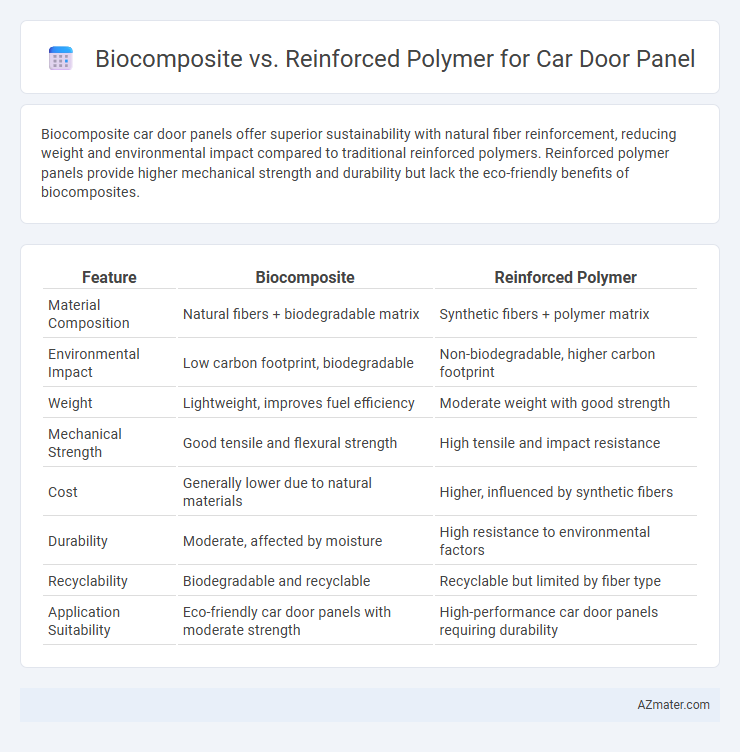Biocomposite car door panels offer superior sustainability with natural fiber reinforcement, reducing weight and environmental impact compared to traditional reinforced polymers. Reinforced polymer panels provide higher mechanical strength and durability but lack the eco-friendly benefits of biocomposites.
Table of Comparison
| Feature | Biocomposite | Reinforced Polymer |
|---|---|---|
| Material Composition | Natural fibers + biodegradable matrix | Synthetic fibers + polymer matrix |
| Environmental Impact | Low carbon footprint, biodegradable | Non-biodegradable, higher carbon footprint |
| Weight | Lightweight, improves fuel efficiency | Moderate weight with good strength |
| Mechanical Strength | Good tensile and flexural strength | High tensile and impact resistance |
| Cost | Generally lower due to natural materials | Higher, influenced by synthetic fibers |
| Durability | Moderate, affected by moisture | High resistance to environmental factors |
| Recyclability | Biodegradable and recyclable | Recyclable but limited by fiber type |
| Application Suitability | Eco-friendly car door panels with moderate strength | High-performance car door panels requiring durability |
Introduction to Car Door Panel Materials
Car door panels commonly utilize materials such as biocomposites and reinforced polymers to balance weight, durability, and cost. Biocomposites integrate natural fibers like hemp or flax with biodegradable resins, offering enhanced sustainability and lightweight properties. Reinforced polymers, typically combining plastics with glass or carbon fibers, provide superior mechanical strength and impact resistance essential for vehicle safety.
Overview of Biocomposites in Automotive Applications
Biocomposites in automotive applications offer lightweight, renewable alternatives by combining natural fibers such as flax, hemp, or jute with polymer matrices, enhancing environmental sustainability and reducing carbon footprint. These materials provide comparable mechanical properties to reinforced polymers while improving recyclability and lowering overall vehicle weight, contributing to better fuel efficiency. Their increasing use in car door panels highlights the automotive industry's shift towards eco-friendly materials without compromising performance and durability.
Reinforced Polymers: Composition and Uses
Reinforced polymers for car door panels typically consist of a polymer matrix such as polypropylene or epoxy combined with reinforcing fibers like glass or carbon fibers, enhancing mechanical strength and impact resistance. These composites provide superior durability, lightweight properties, and improved structural integrity, making them ideal for automotive applications requiring high performance and safety standards. Their widespread use in car door panels supports fuel efficiency and noise reduction while maintaining cost-effectiveness and ease of manufacturing.
Mechanical Properties Comparison
Biocomposite car door panels exhibit improved environmental sustainability and comparable tensile strength to reinforced polymers, typically achieving tensile strengths around 50-70 MPa versus 60-80 MPa for glass fiber-reinforced polymers. Reinforced polymers often demonstrate superior impact resistance and higher modulus of elasticity, with impact strength values exceeding 30 kJ/m2 compared to 10-20 kJ/m2 in biocomposites. Both materials offer distinct mechanical benefits, where biocomposites provide weight reduction and eco-friendly alternatives, while reinforced polymers maintain higher durability and stiffness essential for automotive safety standards.
Weight and Fuel Efficiency Considerations
Biocomposite car door panels typically weigh 15-30% less than reinforced polymer counterparts, reducing overall vehicle mass and enhancing fuel efficiency by up to 5%. The lower density of natural fibers in biocomposites contributes to decreased energy consumption during driving. Reinforced polymers, while durable, often add more weight, negatively impacting miles per gallon (MPG) and increasing carbon emissions.
Environmental Impact and Sustainability
Biocomposite car door panels, composed of natural fibers and biodegradable resins, offer significantly lower carbon footprints and reduced landfill waste compared to reinforced polymers that typically use synthetic fibers and non-recyclable plastics. The production of biocomposites relies on renewable resources and emits fewer greenhouse gases, enhancing sustainability throughout the vehicle lifecycle. In contrast, reinforced polymers, while providing high structural strength, pose environmental challenges due to resource-intensive manufacturing and limited end-of-life recyclability.
Cost Analysis: Biocomposite vs Reinforced Polymer
Biocomposite materials for car door panels offer a cost advantage due to lower raw material prices and reduced energy consumption in processing compared to reinforced polymers. Reinforced polymers, while providing higher mechanical strength and durability, involve more expensive additives like carbon fibers and complex manufacturing processes that drive up overall costs. Evaluating lifecycle costs reveals biocomposites can reduce expenditures in both production and end-of-life recycling, making them a more economical choice for automotive applications.
Durability and Lifespan
Biocomposite car door panels exhibit enhanced environmental sustainability but generally offer lower durability and shorter lifespan compared to reinforced polymer counterparts, which benefit from superior mechanical strength and resistance to impact, corrosion, and weathering. Reinforced polymers, often enhanced with glass or carbon fibers, maintain structural integrity under prolonged stress and extreme temperatures, resulting in longer service life for automotive applications. The choice between biocomposites and reinforced polymers hinges on balancing eco-friendliness with performance requirements, particularly where durability and lifespan are critical.
Manufacturing and Processability
Biocomposite car door panels offer enhanced sustainability with easier integration into existing injection molding processes, leveraging natural fibers like hemp or flax that reduce weight and energy consumption during manufacturing. Reinforced polymers, typically utilizing glass or carbon fibers, require more complex processing techniques such as compression molding or RTM (Resin Transfer Molding) to achieve high strength and durability. Processing biocomposites generally involves shorter cycle times and lower emissions, making them more cost-effective and environmentally friendly for automotive door panel production.
Future Trends in Car Door Panel Material Selection
Future trends in car door panel material selection emphasize lightweight biocomposites that enhance sustainability and reduce vehicle emissions compared to traditional reinforced polymers. Advancements in natural fiber reinforcements and bio-based resins offer improved mechanical properties and recyclability, aligning with stricter environmental regulations. The growing demand for eco-friendly, high-performance materials drives innovation toward biocomposites with comparable strength and durability to reinforced polymers in automotive applications.

Infographic: Biocomposite vs Reinforced Polymer for Car Door Panel
 azmater.com
azmater.com